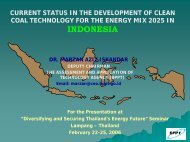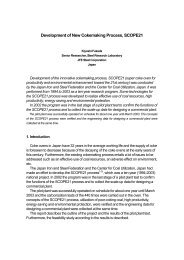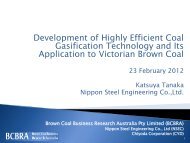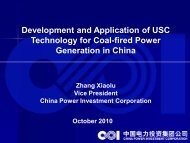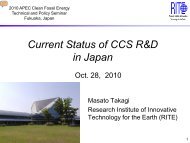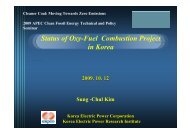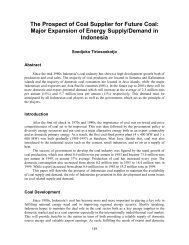Defining CCS Ready: An Approach to An International Definition
Defining CCS Ready: An Approach to An International Definition
Defining CCS Ready: An Approach to An International Definition
- No tags were found...
Create successful ePaper yourself
Turn your PDF publications into a flip-book with our unique Google optimized e-Paper software.
Appendix B: Technology Design Options for a Capture <strong>Ready</strong> Plantensuring enough land and building space, the only major expense for this option is the FrontEnd Engineering Design (FEED) work <strong>to</strong> plan for retrofitting an amine-based CO 2 capturesystem. In the FEED design work, provisions would be made for incorporation of a throttlevalve, ducting, and extraction steam piping <strong>to</strong> the amine reboiler. The throttle valve would beinstalled once the amine unit is retrofitted, and would be used <strong>to</strong> extract steam at a pointbetween the intermediate and first low-pressure steam turbines.Option 2 (Clutch case): The second option represents a more costly approach thanOption 1, with the benefits of lowering <strong>to</strong>tal capture costs and improved heat rateperformance. FEED work will be similar <strong>to</strong> Option 1, with the exception of design andincorporation of a clutch between the two low-pressure steam turbine stages. With 50%steam extraction for the amine reboiler, declutching the second low-pressure steam turbinestage from operation would improve heat rate performance.Option 3 (Oversize case): This option represents a different Capture <strong>Ready</strong> approachfrom those in Options 1 and 2. Instead of modifying the steam turbine for incrementalperformance gains in heat rate, Option 3 increases the size of the steam furnace such thatthere is no loss in electric output capacity (MW) compared with the reference plant after aCO 2 capture retrofit. The reference plant’s initial gross capacity of 580 MW is upsized <strong>to</strong>approximately 660 MW. All downstream systems are upsized as well <strong>to</strong> accommodate boththe increase in steam flow as well as flue gas. It is assumed that before CO 2 captureretrofitting, the boiler will be operated at partial load with no heat rate penalty.B.1.3 Economics of Post-Combustion Capture <strong>Ready</strong> OptionsExhibit B-2 below presents a line-item breakdown of the typical capital costs for thepulverized coal reference plant, located in the United States, in 2007 US dollars. 128 Theovernight <strong>to</strong>tal plant cost for the supercritical PC station is approximately US$866 millionor US$1,575 per kW. Total plant costs exclude all owner costs, such as rail spurconnection, transmission interconnections and upgrades, interest during construction, etc.Note that these numbers are meant for illustrative purposes only, and they are sensitive <strong>to</strong>the chosen assumptions. They mostly serve <strong>to</strong> illustrate the usefulness of a Capture <strong>Ready</strong>plant, not the optimal degree of readiness for all situations.The incremental costs for Capture <strong>Ready</strong> design Options 1, 2, and 3 are also shown inExhibit B-2. The incremental cost of $4.4 million for Option 1 reflects the upfrontengineering design fees associated with accommodating a post-combustion amine-basedCO 2 capture system sometime in the future. Incremental costs of approximately $25 millionfor Option 2 reflect both the design fees consistent with Option 1 and the clutchmechanism between the two low-pressure steam turbine stages. The clutch installation andmaterials costs amount <strong>to</strong> approximately $20 million. Option 3 has the largest incrementalcapital cost requirements of approximately $444 million, as it represents the upsizing of thesteam furnace and all associated downstream systems that need <strong>to</strong> accommodate a largersteam and flue gas flow. The cost of the additional land area is not included in this analysis. 129128 The cost is given in 2007 US dollars since the NETL Capture <strong>Ready</strong> Report (U.S. DOE-NETL, 2008b ) used 2007 USdollars as its basis.129 Given that the design Options 1 and 2 are based on the IEA GHG report, and the design Option 3 was based on NETLreport, there are differing capital cost assumptions behind these two reports. ICF has conducted a first-order reconciliation ofthe different cost assumptions, and the numbers shown in Exhibit B-2 reflect this reconciliation process.23 February 2010 79



